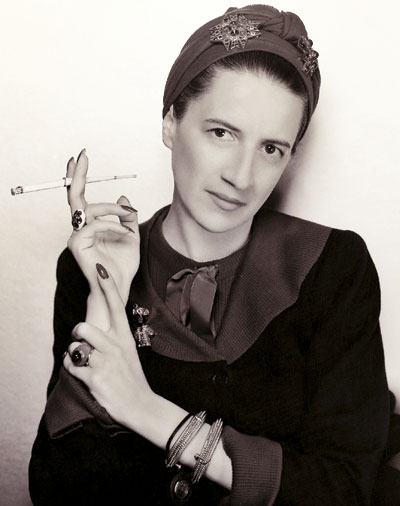Over 80 and almost blind, Diana Vreeland was wheeled around a forthcoming costume exhibition at the Metropolitan Museum, issuing instructions all along the way about hats, shoes, lights and mannequins. She seemed, recalled the writer Andrew Solomon,
an impossible old lady who couldn’t let go of her control and who was making everyone’s lives miserable for no good reason. And they did everything she’d said, and it was transformed. Her nearly sightless eyes could pick out things my youthful vision could not; enfeebled, she was still supreme at the discipline of chic.
From childhood, Diana Vreeland had operated with deep faith in the power of self-presentation. She transformed herself from an ugly, unpopular child into the ‘Empress of Fashion’, who had the soles of her shoes polished and who spoke in her own, heavily stressed, poetic idiom. She was an extraordinary creature with prodding red talons, black hair so shiny it was said to have clinked in contact with metal, Vaselined eyelids and the gait of a dromedary, upper body sloping backwards, pelvis thrust forward.
Vreeland had thought she would simply live a stylish life, rather than a professional one, but when she was in her thirties she was recruited by Carmel Snow at Harper’s Bazaar and she happily took to putting her stamp on her readers’ wardrobes, houses, children, pets.
Her first column ‘Why Don’t You?’ was a fantastical compendium of styling ideas. Why Don’t You: rinse your blond child’s hair in dead champagne to keep its gold? Put earrings on your furniture? Install a private staircase from your bedroom to the library with a needlework carpet with notes of music worked on each step — the whole spelling out your favourite tune? The spirit of ‘Why Don’t You?’ informed Vreeland’s career, as she moved to fashion editor at Harper’s Bazaar, to editor of Vogue, to costume curator at the Metropolitan Museum of Art.
An endless stream of memos issued from within the scarlet lacquered walls of her office at Vogue: the serpent should be on every finger and all wrists; let’s promote grey; I am extremely disappointed that no one has taken the slightest interest in freckles.
Amanda Mackenzie Stuart has a sharp eye for the absurd and picks out these details with relish, but she also brings a kind of sense to the nutty world of fashion. The memos were the MO of an eccentric perfectionist who came up with hundreds of ideas a week.
Fond of an oblique briefing, Vreeland used to ask stylists for the suggestion of something she’d never seen. Sometimes she offered slightly more guidance: a photograph of one sequined dress was supposed to give the impression that the whole world tasted of salt water. She enjoined the stylist Polly Mellen to familiarise herself with the 845-page Tales of Genji before setting foot in Japan — without having read it herself. At a hint from her, Vreeland’s teams would fly quantities of gold hair to Tahiti to style the finest white stallions, only to find they’d all been eaten by the French; they’d get stranded on a mountain because John Cowan was so determined to make it look as if the models were floating in the clouds.
If you’re not part of the fashion world, this sort of thing sounds simply frivolous and out of touch with reality, but Mackenzie Stuart explains that this was entirely the point. Vreeland’s edicts and oracular utterances — blue jeans are the most beautiful thing since the gondola — all fitted with the case she made for fashion that it should be an ‘intoxicating release from the banality of the world’, that Vogue should be ‘the myth of the next reality’ and that the extremes she presented could inspire the wardrobes of ordinary women. And with some people, the ‘show me a dream’ style of management worked — photographers such as Richard Avedon and David Bailey helped Vreeland create a new kind of fashion spread.
The research for this book has been exhaustive, but Mackenzie Stuart wears it lightly — almost incidentally she gives a thorough tour of 35 years of fashion. She writes movingly about Vreeland’s marriage without any intrusive psychoanalysis, and her warmth, enthusiasm and peculiar genius come through in entertaining anecdotes and marvellous, very italicised, quotes.





Comments